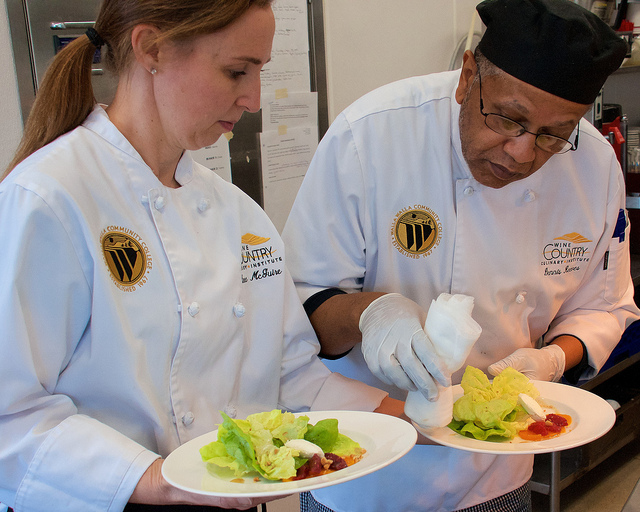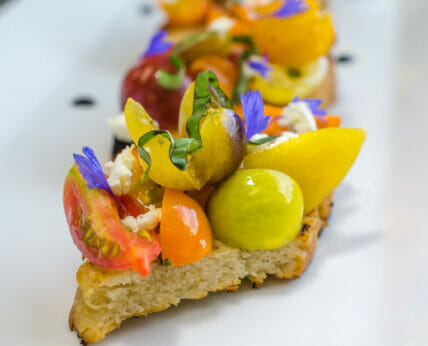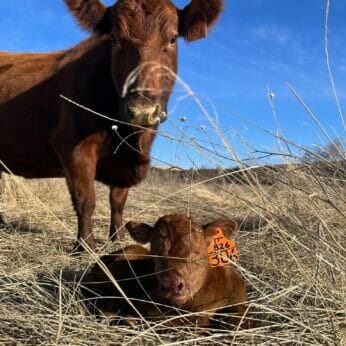Community colleges are increasingly bringing hands-on food production into curricula in new and innovative ways.

On the back 16 acres of Walla Walla Community College, 30 Red Angus cows stand munching on hairy vetch, ryegrass and other cover crops that were planted to help restore the soil.
The cattle, which were artificially inseminated by students in the spring, will eventually be harvested at a USDA plant and incorporated into the fine dining menu at the college’s student-run campus restaurant, Capstone Kitchen.
Those cows are just one part of the closed-loop system the college aims to highlight in its new farm-to-fork program that is rolling out this school year. “The agriculture students will be growing and raising specialty crops and animals for us, and culinary students will get the chance to get their hands in the dirt to learn what it takes to grow a crop,” says chef-instructor and Top Chef alum Robin Leventhal. “It’s truly full circle.”
Walla Walla’s hands-on coursework is bringing together agriculture and culinary students as part of a nascent movement among community colleges that are increasingly bringing food production into curricula in new and innovative ways.
Walla Walla Community College’s program may be one of the most extensive culinary-agriculture curriculums, but there are others. Bakersfield College boasts an Edible Gardens Catalog program, Kalamazoo Community College offers Sustainable Food Systems Competencies coursework and Greenfield Community College’s Farm and Food Systems covers mushroom foraging and cultivation, permaculture design, beekeeping, food preservation and more.
The federal government is trying to help spur growth in these types of programs, too. As part of its efforts to foster a new crop of farmers, earlier this year, the USDA announced it would be investing $262.5 million in grants to higher education programs that serve underrepresented student populations as part of an inaugural program to build and sustain the next generation of the food and agriculture workforce.
Bergen Community College was one of the grant recipients, receiving a $4.5-million grant for its soon-to-come vertical farming, hydroponics and plant-based culinary arts programs. The grant, which will provide funding through June 2028, will help the college to enhance its current culinary, horticulture and science curriculum with new classwork that will explore sustainable food production and safety practices, waste management and agribusiness. “We already have horticulture and culinary programs, but this agriculture is new,” says PJ Ricatto, Ph.D., who will direct the new project. “As a suburban community college, we just ignored food production in our educational programs—and that’s going to change.”
The school ran an outdoor hydroponics farm this summer to help work out logistics on the soon-to-be-built indoor vertical farm. The next step is to get a greenhouse going in the fall and eventually scale up into a series of shipping containers. Over time, the administrators hope to expand with aquaculture, waste management, raised-bed gardening and more. Local vertical farmer Greens Do Good, which already offers training and employment for neurodiverse individuals, will be a close collaborator in the project. The company will help support the operation of the hydroponic facility, as well as provide learning and internship opportunities and potential employment paths for neurodiverse project participants and others.

Walla Walla’s hands-on coursework is bringing together agriculture and culinary students. (Photo courtesy of WWCC)
These ties to local industry and economic needs are what make these sorts of programs so impactful. “The beauty of community college in the United States is it’s there to serve the community,” says Dr. Martha M. Parham, senior vice president of public relations for the American Association of Community Colleges. “They’re fueling the workforce pipeline in a lot of cases.”
“Colleges have to teach what’s trending, and the next generation is looking at what impact we have in this world and how we can support our community.”
While they differ in the students’ backgrounds and types of communities they serve, these new agricultural programs have quite a bit in common.
Like Walla Walla, the produce grown in Bergen Community College’s hydroponic learning lab facilities will also be used in the Culinary Arts program’s student-run cafeteria. Whatever is not used in that restaurant may end up being sold at a campus farm stand or donated to the school’s food pantry. Walla Walla Community College hopes to offer surplus agricultural products at its food pantry, too.
Studies have found that more than one-third of college students experience food insecurity at some point during their enrollment.
But where Bergen Community College aims to foster new farmers in a suburban-urban environment through vertical farms and hydroponics, Walla Walla’s program will expand upon an existing agroecology curriculum geared toward its rural students, many of whom may be seeking to bring their education back to family farms or other local agriculture. “Most of the people in our ag program are coming from an agrarian background but are trying to be innovative with new ways to approach farming,” says Leventhal.

Red Angus cows help students learn about agroecology at Walla Walla Community College. (Photo courtesy of WWCC)
The school, which is located in Washington State’s premier wine region, boasts one of the few agroecology-focused bachelor’s of applied science (BAS) degrees in the country. Several classes discuss using ecology principles to inhibit or get rid of weeds, for example. This coursework examines methods to use in various farming systems, including the crops or animals being reared, acreage, infrastructure, equipment and other factors that will impact a farm’s ability to reduce input costs while maintaining profitable production per acre. So, bringing in the cows (which are owned by a school instructor) to see what weeds they prefer to eat, and when, is an ideal demonstration for students who are trying to understand how these sorts of regenerative principles translate on an actual farm. “Agroecology incorporates the whole food systems and dynamics of the community,” says Alan Raeder, Ph.D., director of the Agriculture Science program. As part of that study, he says, “We are trying to produce and grow plants and animals that we need, and want to harvest them as close by as we can.”
While those bovines have been helping to restore the soil on their temporary pasture, the 18 raised beds that were planted last year and ⅛-acre demonstration field have all been prepared for the students who will be starting the program in September. About 100 pounds of potatoes have been harvested, and the already-planted tomatoes, chiles, herbs, green beans and cabbage will all be ready for students to work with when classes begin.
Many of the seeds were picked out last year, but the goal of the program is for both culinary and agriculture students to work with professors to not only figure out what will grow best and have the highest yields in the environment but what will impress customers in the restaurant. For upcoming semesters, that will likely include bright winter vegetables such as watermelon radishes, Chioggia beets, golden beets and other colorful, cold-hardy crops. “Finding the right fit is part of the trial and error of this, which is educational,” says Leventhal.
Selecting animals to raise and harvest will be a big part of the curriculum, too, but it is likely a bit farther out as the program gets better established. The program mimics the relationships between chefs and local farmers, so the students can work together in brainstorming what foods to cultivate for the restaurant and bistro—a real-world skill that Walla Walla Community College culinary and agriculture students are eager to learn. “Students drive curriculum,” says Leventhal. “Colleges have to teach what’s trending, and the next generation is looking at what impact we have in this world and how we can support our community—that’s such an important conversation that’s happening right now.”
Inspiring !